[Policies] Focus on Shanghai green building policies and incentives
According to the World Green Building Council, buildings and their construction sectors combined contribute to almost 40% of global carbon emissions and 36% of global final energy consumption (Source: New strategy tackles the climate emergency in a post-COVID built environment). Green buildings, if properly designed, have been demonstrated to reduce greenhouse gas emissions by more than 60% compared with average buildings (Source: The Value of Green Star – A Decade of Environmental Benefits).
At the moment, China is the biggest energy consumer in the world and the energy consumption in buildings is the second-largest right after the US. Chinese Government, as a member of the World Green Building Council, is moving fast by implementing multiple regulations, committing to promote green building transformation to create more livable and sustainable cities.
As a super first-tier city in China, Shanghai takes the lead in continuously improving and implementing green building policies and financial incentives. Since 2019, 100% of new civil buildings (residential buildings and public buildings not involved in industrial activities) in Shanghai have implemented green building standards (Source: Shanghai Green building Development Report (2019), Shanghai Green Building Development Report (2020)).
For LEED certification projects, Shanghai has been No.1 in China for at least three consecutive years (Source: China Adds 873 LEED-Certified Projects in 2020, Shanghai Takes Solid Lead).
The followings are part of the official documents in Shanghai.
Document 1: Shanghai Green Building Development Report (2020)
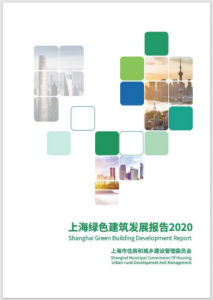
The “Shanghai Green Building Development Report” summarized the financial support documents encouraging green buildings and building energy efficiency in different districts in Shanghai, as below:
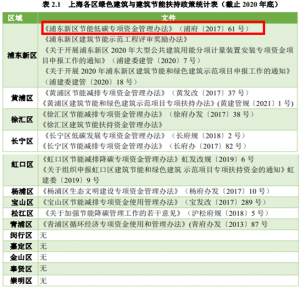
You can see “Pudong New District Energy Conservation and Low-Carbon Special Fund Management Measures” is framed in red. According to this policy, Shanghai Pudong District provides a 20% subsidy for the initial installation of renewable energy for new buildings and renovating buildings, which is the highest in China (Source: Notice of the People’s Government of Shanghai Pudong New District on Printing and Distributing the “Pudong New Area Energy Conservation and Low-Carbon Special Fund Management Measures”). Therefore, it is a very good opportunity to help both new buildings and existing buildings with the first try of installing renewable energy at the moment.
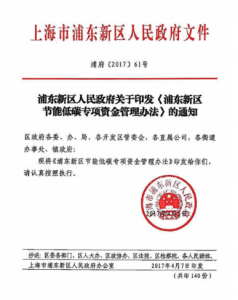
Document 2: 14th FYP Green Building, Shanghai City Planning (2021)
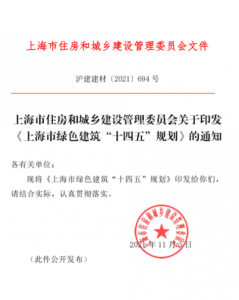
The “14th FYP Green Building, Shanghai City Planning” pointed out that all new civil buildings are required to be constructed following the basic level of GBL and above. Among them, new large public buildings need to achieve 2 stars (office buildings of national organizations, large public buildings and other government investment projects over 5,000 sqm) or 3 stars (super high-rise buildings or buildings in the 5 new districts* in Shanghai) based on GBL.
The document emphasizes the healthy performance of green buildings and requests for a Civil Building Carbon Peak Action Plan to control the carbon emissions related to buildings at about 45 million tons. Also, it is necessary to promote building energy-efficiency design transformation from ‘relatively energy efficient’ to ‘energy consumption limit’.
* 5 new districts: Lingang District, Jiading District, Songjiang District, Qingpu District, Fengxian District.
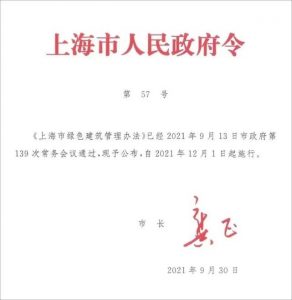
Document 3: Shanghai Green Building Management Measures (Hufu Order No. 57) (2021)
The “Shanghai Green Building Management Measures (Hufu Order No. 57) (2021)” encourages the adoption of contract energy management, professional hosting for green operations, and other innovation models in green building activities. Shanghai also commits to promoting building-integrated distributed photovoltaic power generation systems and green materials.
This document also stated that Shanghai encourages the pilot demonstration of ultra-low energy consumption buildings, nearly zero energy consumption buildings, and zero carbon emission buildings.
Document 4: Shanghai Building Energy Conservation Regulations (2021)
The “Shanghai Building Energy Conservation Regulations” focuses on the energy consumption standards and test regulations of new buildings, and the energy-saving measures as well as the maintenance of existing civil buildings. It also clears the incentives and punishments for civil buildings.
For example, financial institutions are encouraged to provide credit support for civil building energy conservation projects in accordance with national regulations.
Any developments that offend subsections 2 and 3 of paragraph 11, which fail to install the required solar water heating system or renewable energy utilization system shall be ordered to make corrections within a time limit and be fined 50,000 yuan to 500, 000 yuan.
For more green building and building efficiency policies in Shanghai, you can access the following links:
Interesting energy-efficient related measures:
- 6.3.1 The building’s window-to-wall area ratio, the area of the transparent roof, the area of the atrium transparent roof, and the thermal performance of the enclosure structure, etc., shall comply with the current Shanghai Engineering Construction Code “Energy-saving Design Standards for Public Buildings (DGJ 08-107)”.
- 10.5.1 New large-scale public buildings and government office buildings should establish a building energy consumption measurement system to classify and sub-measure water, electricity, gas, fuel oil, central heating, central cooling, renewable energy, and other energy consumption types.
- Shanghai Green Design Standards for Residential Buildings (DGJ 08-2139-2018)
This policy made some improvements compared with its previous version:
- The requirements for water-saving and sanitation are detailed, the requirements for the use ratio of water-saving appliances in fully furnished residential buildings are clarified.
- The air treatment requirements are clarified and it is emphasized that the underground garage should be equipped with a carbon monoxide concentration monitoring device linked with the exhaust equipment.
- The requirements for safety, energy-saving, fire prevention, and intelligence of electrical design and electrical products are clarified.
In Shanghai, the depth of green building design shall meet the requirements of “Shanghai Green Building Engineering Design Document Preparation Depth Regulations (2021 Revised Edition)”.
In Shanghai, the construction drawing review agency shall review whether the project meets the green building grade and corresponding standards in strict accordance with “Key Points for Review of Design Documents for Green Design and Construction Drawings of Public Buildings in Shanghai (2020)” together with “Key Points for Review of Design Documents for Green Design and Construction Drawings of Residential Buildings in Shanghai (2020)” below.
- Key Points for Review of Design Documents for Green Design and Construction Drawings of Residential Buildings in Shanghai (2020)
- Acceptance standards for green building projects (Shanghai Engineering Construction Code) (DG/TJ08-2246-2017)
This policy applies to the acceptance of new, expanded, rebuilt, and renovated civil green buildings in Shanghai.
This policy stipulates that when new residential buildings are sold, there should be an energy-saving “file” in the instruction manual.
For any asset around China or South-East Asia, whether it is a civil building or an industrial building, we would be happy to help you design a more sustainable building. If you need more details, please do not hesitate to contact our Business Development Manager, Gaspard Lemoine-Scelles through his email address: glemoinescelles@teraoasia.com.
Written by Crystal Ren

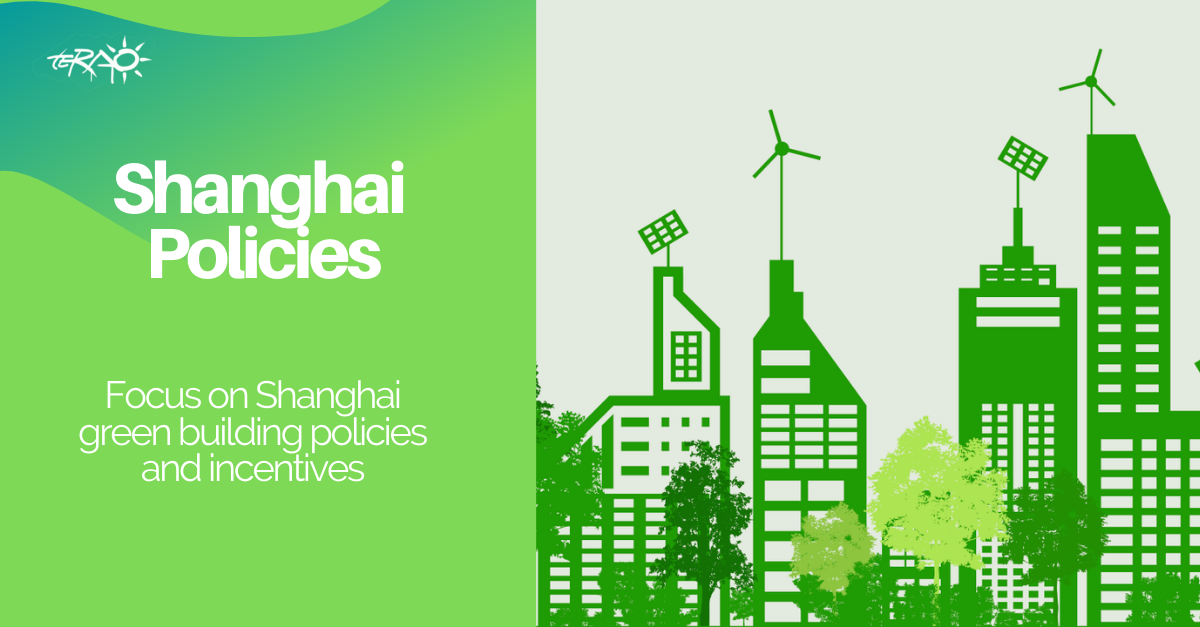
![[Expertise] How to conduct an energy audit to identify areas of energy waste in business](https://teraoasia.com/wp-content/uploads/2024/06/Expertise-1-150x150.jpg)

Leave A Comment